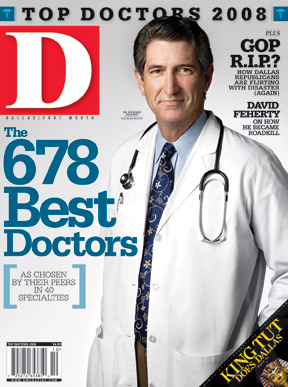illustrations by Kent Barton
 |
Dr. Oscar Milton Marchman Sr.
Born on April 5, 1872, in Jefferson, Texas, Marchman attended Alexander Institute in Kilgore to become a registered pharmacist. He earned his medical degree at Washington University, in St. Louis, and received postgraduate training in New York, Chicago, Vienna, St. Louis, and New Orleans.
Marchman moved in 1906 to Dallas, where he would live and serve the rest of his life. He started as a general practitioner. He was named president of the Dallas chapter of the American Red Cross and was secretary of the Dallas Board of Health from 1907 to 1911. Marchman also served as president of the Van Zandt County Medical Society, the Dallas County Medical Society, and both the Dallas and the Texas Ophthalmological and Otolaryngological societies. For five decades, he was a member of the Texas Medical Association, and he served as vice president of the association. In 1955, he was honored as a member emeritus.
By 1924, Marchman focused his practice solely on otolaryngology. He was a staff member at Baylor and Texas Children’s hospitals, and he served as a professor at Baylor University College of Medicine in Dallas. Marchman was also the head of the Department of Clinical Otolaryngology at Southwestern Medical School. In 1946, the Dallas Academy of Medicine, of which Marchman was a founding member, established the Dallas Health Museum. Marchman was also a founding member and trustee of the museum. The Dallas Health Museum eventually grew into what is known today as the Museum of Nature and Science.
Marchman was a member of the Southern Medical Association, the World Medical Association, and the American Medical Association. The Marchman Award, once presented to physicians by the Dallas Southern Clinical Society, was named in his honor for a physician who had made outstanding contributions in medical education and research. The doctor was also active in the community, where he was a member of the Greater Dallas Planning Council, the Dallas Historical Society, the Dallas Athletic Club, and the Exchange Club. Marchman died in the city he’d served for more than 50 years on May 24, 1959.
 |
Dr. Ruth Jackson
Born on a farm near Jefferson, Iowa, in 1902, Jackson moved with her family to Texas and enrolled at the University of Texas to study sociology. But she discovered that the cause of many economic problems was poor health and shifted her interest to medicine. In 1924, Jackson was accepted at Baylor University School of Medicine in Dallas. The four women in the class of 120 had to score 10 points higher than the male students just to stay in school. Jackson, who stood at just 4 feet 10 inches, liked to say, “I may be little, but I’m mighty.”
She discovered orthopedics while working with polio patients under the guidance of Dr. Arthur Steindler at the University of Iowa. Jackson returned to Dallas in 1931 to become a resident orthopedic surgeon at Scottish Rite Hospital. The following year, Jackson established her private practice at the Medical Arts Building. She initially specialized in foot problems because she believed there would be a wider patient base.
Shortly after she suffered a neck injury, her practice’s focus began to change. She turned her attention to neck problems. She made do with meager resources to expand her skill base and once bought a “skull drill” at a local hardware store. She used a darning needle to stitch up head injuries.
Her perseverance and hard work paid off. Jackson was on staff at Baylor, Methodist, and Parkland hospitals. In 1936 she was appointed chief of orthopedic service at Parkland. Despite these accomplishments, the newly formed American Academy of Orthopedic Surgeons didn’t welcome Jackson, who was at the time the only female orthopedist in the United States. She worked for four years to change the academy’s decision and eventually became the first female member in 1937. Just 12 years later, she was named president of the Texas Orthopedic Association.
Jackson wrote four editions of The Cervical Syndrome and developed a special pillow for patients with neck injuries, the Jackson Cervi-Pillow. When she retired in 1989, it was said that the number of patients she had served could fill the Cotton Bowl.
Today, the Ruth Jackson Orthopedic Society, which promotes professional development for female orthopedists, has 450 members worldwide. Jackson died in 1994 at the age of 91.
 |
Dr. Cecil O. Patterson
Patterson is one of the fathers of gastroenterology in Dallas. Born in 1901 in Creechville, Texas, he spent his youth in the small town of 20 before leaving in 1918 to attend at Southern Methodist University. After finishing his undergraduate studies, he enrolled at the Baylor College of Medicine in Dallas and graduated in 1931.
Patterson was one of the earliest gastroenterologists in Texas, and because he was the first physician in Dallas to use the endoscope, he was called the “father of endoscopy.”
Despite the primitive design of early endoscopic instruments, Patterson was known among his peers for his masterful technique and unique applications of the device, including injecting healing agents deep within a body and retrieving foreign objects from the stomach. When the semi-flexible gastroscope was developed, he was among the first to use it.
The introduction of the fiber-optic endoscope in the 1950s dramatically reshaped the field, and once again Patterson was at the forefront of the change. He led the conversion of the specialty from his position on the staff of Baylor University Medical Center. Because of his vast knowledge in the field and his willingness to share it, he could also be seen roaming the halls of Medical Arts Hospital, Children’s Medical Center, and the Veteran’s Administration hospitals in Dallas and McKinney. And Patterson volunteered two or three days a week at Parkland Memorial Hospital, doing endoscopy on indigent patients. For more than 40 years, until just before his death in 1993, he shared his knowledge and skills with students at UT Southwestern Medical Center.




